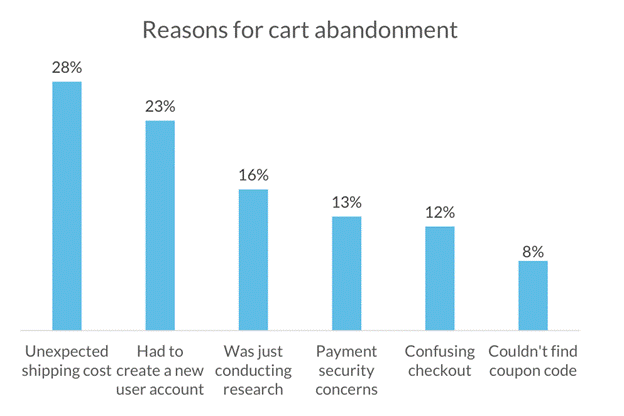Reducing cart abandonment: retail strategies to increase e-commerce engagement
 As an online retailer heading into the holidays with approximately $105 billion in sales up for grabs, competing for spend is a top priority. To maximise your share of holiday sales – and improve sales all year long – it’s critical to enhance the shopping experience and decrease shopping cart abandonment.
As an online retailer heading into the holidays with approximately $105 billion in sales up for grabs, competing for spend is a top priority. To maximise your share of holiday sales – and improve sales all year long – it’s critical to enhance the shopping experience and decrease shopping cart abandonment.
Top reasons for abandoned carts
According to the Baymard Institute, approximately 68% of online shopping carts are abandoned. What makes consumers leave products behind?
The factors most often cited include unexpected shipping costs, the need to create a new account, the customer being in the research phase and payment security concerns. These factors are followed by confusion at checkout and being unable to find a coupon code – two factors that speak to consumers’ desire to use a quick and simple checkout that integrates deals and discounts without having to search.
Now, add the other possible distractions associated with shopping online (social media and interruptions at the home or office, to name a few), and it’s easier to see cart abandonment as a part of the buying cycle. However, retailers do not have to settle – your goal as an online retailer is to provide a safe and simple shopping experience, which can drive increased engagement and potentially sales from your customers.
Tips for reducing shopping cart abandonment
As you can see from the chart above, there are real, actionable steps you can take to optimise your customer checkout experience. While we can’t do much about life’s interruptions, we can give you some tips to address each of these issues.
- Shipping costs and timelines: Make sure you’re putting standard shipping costs in plain sight throughout your site and in your checkout process. This can be as simple as advertising that you offer standard shipping for free or at a low, flat rate (don’t forget to name the dollar amount). Make sure customers know how long it will take to get their purchases with each shipping method. Free shipping that takes six to eight days is far different from free shipping with an unspecified delivery date.
- Customer accounts: Consider adding a guest checkout option in addition to account sign-up. If you want to incentivise converting that guest checkout to an account, offer the ability to track the shipment and the simplicity of adding a password after the checkout is complete. This lets guests stay guests and could motivate users to complete the final mile of account set-up – adding a password to all the other shipping and billing information they already took the time to enter.
- Researchers: Lots of consumers choose to comparison shop. Rather than fighting this behavior, consider adding a Save Cart function for your committed comparison shoppers, allowing them to return to your site and complete their purchases at a later time.
- Payment methods: Along the lines of payment security, try to give your customers a wide variety of ways to pay, from credit and debit cards to other methods, so as not to turn away payment methods. Be sure to include Discover, as these cardholders are loyal to their Discover Card due to the benefits and rewards they receive.
 “At the heart of e-commerce is a smooth and simple payment experience, which makes payment acceptance a critical component of a holistic e-commerce platform,” said Brian Meier, director of strategic merchants at Discover.
“At the heart of e-commerce is a smooth and simple payment experience, which makes payment acceptance a critical component of a holistic e-commerce platform,” said Brian Meier, director of strategic merchants at Discover.
“Consumers often look to use a card they’re loyal to when they pay due to the lucrative rewards they receive. Retailers can tap into this behaviour by offering broad payment acceptance, allowing consumers to pay with their preferred card.”
Reaching customers after they’ve left your site
Now, even if you’ve made all of the above tweaks to your checkout process, you could still have abandoned carts, but one opportunity is email re-marketing. This is a reminder e-mail sent after a specified time to your customers, provided that you have their emails, reminding them that they’ve left an item in their shopping carts and sometimes offering a discount incentive to come back.
Several services exist to help retailers with retargeting, such as Barilliance, Dynamic Yield and Carts Guru, and can help with reaching customers who didn’t complete a purchase. Through re-marketing efforts, site visitors who have abandoned their carts might see the items they left in their carts displayed in ads on different sites, reminding them of what they’d intended to buy. The ads link to your company’s website so they can complete their purchase. Re-marketing campaigns, in essence, allow the items in a customer’s cart to “follow” them around the internet. These repeated impressions increase the chance of the customer completing his/her purchase.










































